WBOR 91.1FM
Spring 2003, Issue 2
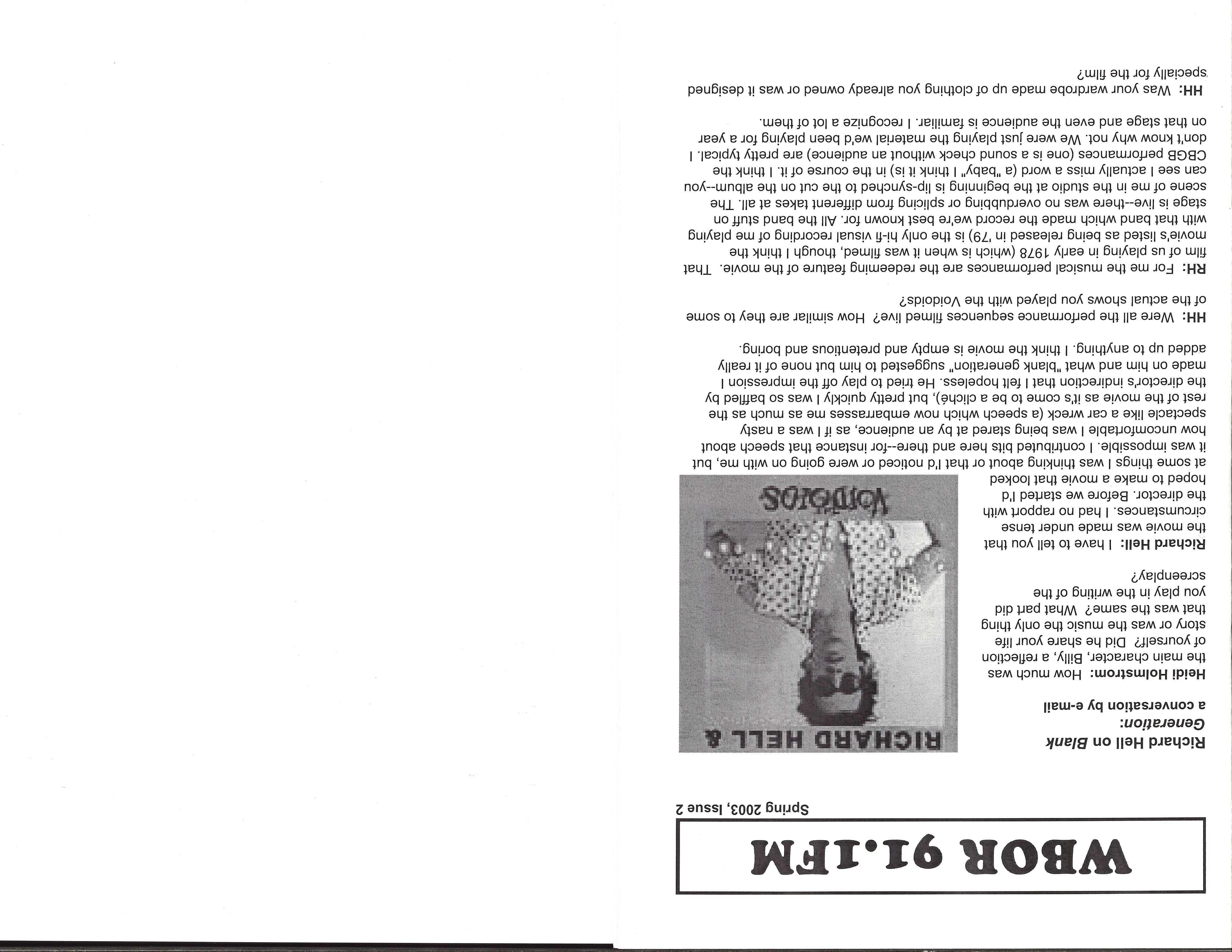
Richard Hell on Blank Generation: a conversation by e-mail
Heidi Holmstrom: How much was the main character, Billy, a reflection of yourself? Did he share your life story or was the music the only thing that was the same? What part did you play in the writing of the screenplay?
Richard Hell: have to tell you that the movie was made under tense circumstances. had no rapport with the director. Before we started l'd hoped to make a movie that looked at some things was thinking about or that I'd noticed or were going on with me, but it was impossible. contributed bits here and there--for instance that speech about how uncomfortable was being stared at by an audience, as if was a nasty spectacle like a car wreck (a speech which now embarrasses me as much as the rest of the movie as it's come to be a cliché), but pretty quickly was so baffled by the director's indirection that | felt hopeless. He tried to play off the impression | made on him and what "blank generation" suggested to him but none of it really added up to anything. think the movie is empty and pretentious and boring.
HH: Were all the performance sequences filmed live? How similar are they to some of the actual shows you played with the Voidoids?
RH: For me the musical performances are the redeeming feature of the movie. That film of us playing in early 1978 (which is when it was filmed, though | think the movie's listed as being released in '79) is the only hi-fi visual recording of me playing with that band which made the record we're best known for. All the band stuff on stage is live--there was no overdubbing or splicing from different takes at all. The scene of me in the studio at the beginning is lip-synched to the cut on the album--you can see actually miss a word (a "baby" think it is) in the course of it. think the
CBGB performances (one is a sound check without an audience) are pretty typical. | don't know why not. We were just playing the material we'd been playing for a year on that stage and even the audience is familiar. recognize a lot of them.
HH: Was your wardrobe made up of clothing you already owned or was it designed specially for the film?
RH: Most of the clothes were mine. never wore a motorcycle jacket in real life though (the leather jacket sometimes wore early on was a police jacket), and never wore that shirt with the spray-painted stripes, though it was made for me by someone was very close to in the mid-seventies, Lizzy Mercier Descloux (who eventually recorded albums herself). Didn't they also put some blond streaks in my hair at some point? never did that. In the earliest days, say 74-76 I'd dye my hair black some times but nothing else.
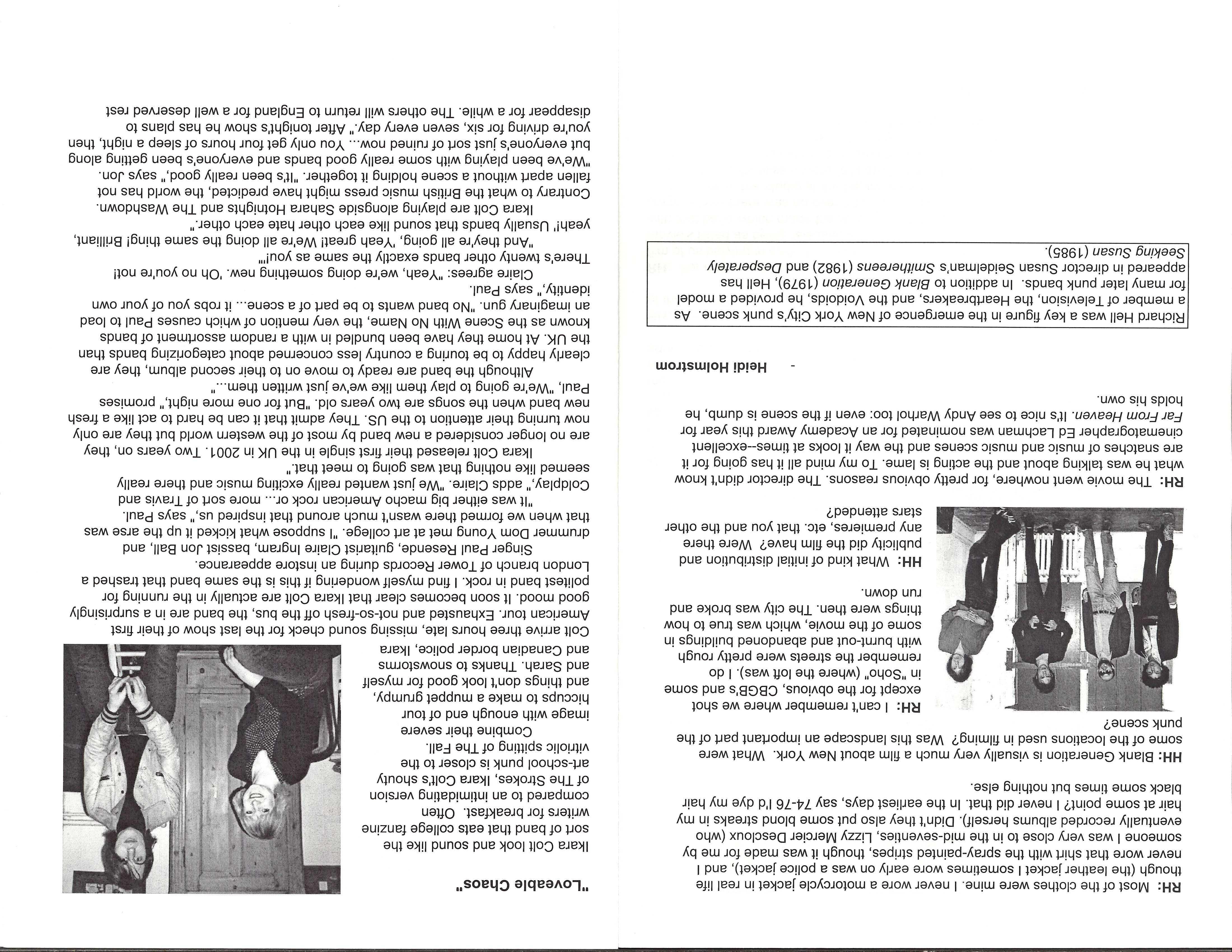
HH: Blank Generation is visually very much a film about New York. What were some of the locations used in filming? Was this landscape an important part of the punk scene?
TE RH: can't remember where we shot except for the obvious, CBGB's and some in "Soho" (where the loft was). do remember the streets were pretty rough with burnt-out and abandoned buildings in some of the movie, which was true to how things were then. The city was broke and run down.
HH: What kind of initial distribution and publicity did the film have? Were there any premieres, etc. that you and the other stars attended?
RH: The movie went nowhere, for pretty obvious reasons. The director didn't know what he was talking about and the acting is lame. To my mind all it has going for it are snatches of music and music scenes and the way it looks at times--excellent cinematographer Ed Lachman was nominated for an Academy Award this year for Far From Heaven. It's nice to see Andy Warhol too: even if the scene is dumb, he holds his own.
- Heidi Holmstrom
Richard Hell was a key figure in the emergence of New York City's punk scene. As a member of Television, the Heartbreakers, and the Voidoids, he provided a model for many later punk bands. In addition to Blank Generation (1979), Hell has appeared in director Susan Seidelman’s Smithereens (1982) and Desperately Seeking Susan (1985).
"Loveable Chaos" Ikara Colt look and sound like the sort of band that eats college fanzine writers for breakfast. Often compared to an intimidating version of The Strokes, Ikara Colt's shouty art-school punk is closer to the vitriolic spitting of The Fall. Combine their severe image with enough end of tour hiccups to make a muppet grumpy, and things don't look good for myself and Sarah. Thanks to snowstorms >, and Canadian border police, Ikara OO a Colt arrive three hours late, missing sound check for the last show of their first American tour. Exhausted and not-so-fresh off the bus, the band are in a surprisingly good mood. It soon becomes clear that Ikara Colt are actually in the running for politest band in rock. find myself wondering if this is the same band that trashed a London branch of Tower Records during an instore appearance. Singer Paul Resende, guitarist Claire Ingram, bassist Jon Ball, and drummer Dom Young met at art college. "| suppose what kicked it up the arse was that when we formed there wasn't much around that inspired us," says Paul.

"It was either big macho American rock or... more sort of Travis and Coldplay," adds Claire. "We just wanted really exciting music and there really seemed like nothing that was going to meet that."
Ikara Colt released their first single in the UK in 2001. Two years on, they are no longer considered a new band by most of the western world but they are only now turning their attention to the US. They admit that it can be hard to act like a fresh new band when the songs are two years old. "But for one more night," promises Paul, "We're going to play them like we've just written them..." Although the band are ready to move on to their second album, they are clearly happy to be touring a country less concerned about categorizing bands than the UK. At home they have been bundled in with a random assortment of bands known as the Scene With No Name, the very mention of which causes Paul to load an imaginary gun. "No band wants to be part of a scene... it robs you of your own identity," says Paul.
Claire agrees: "Yeah, we're doing something new. 'Oh no you
There's twenty other bands exactly the same as you!"
re not!
"And they're all going, 'Yeah great! We're all doing the same thing! Brilliant, yeah!' Usually bands that sound like each other hate each other."
Ikara Colt are playing alongside Sahara Hotnights and The Washdown.
Contrary to what the British music press might have predicted, the world has not fallen apart without a scene holding it together. "It's been really good," says Jon. "We've been playing with some really good bands and everyone's been getting along but everyone's just sort of ruined now... You only get four hours of sleep a night, then you're driving for six, seven every day." After tonight's show he has plans to disappear for a while. The others will return to England for a well deserved rest
À before starting their second album. "Everyone's eager to be getting back. You know, get a nice bath and then wait for all the injuries to heal, and the bruises to disappear."
Those are the last coherent words from Jon for tonight as he is soon distracted by his recent creation - a "dangerous drink likely to cause heart failure and dementia..." As Ikara Colt take to the stage they are clearly suffering from the last five and a half weeks on the road in the US, and the previous two years spent touring Europe. Dom appears to be taking naps between songs and Paul has trouble even speaking.
Earlier, Paul described their live shows as, "Loveable chaos... | think the thing like about us is we're not predictable. You don't know what you're going to get, even we don't. Some nights we're bloody awful and some nights we're kind of alright. But like being unpredictable because think that's the best thing to be. We're unpredictable, that just means we're not boring." Tonight Ikara Colt are on form. They overcome their exhaustion and even Jon manages to postpone heart failure as they storm through a brief but blistering set. As they leave the stage a fuse blows, the power goes out, and Ikara Colt end their first American tour in style.
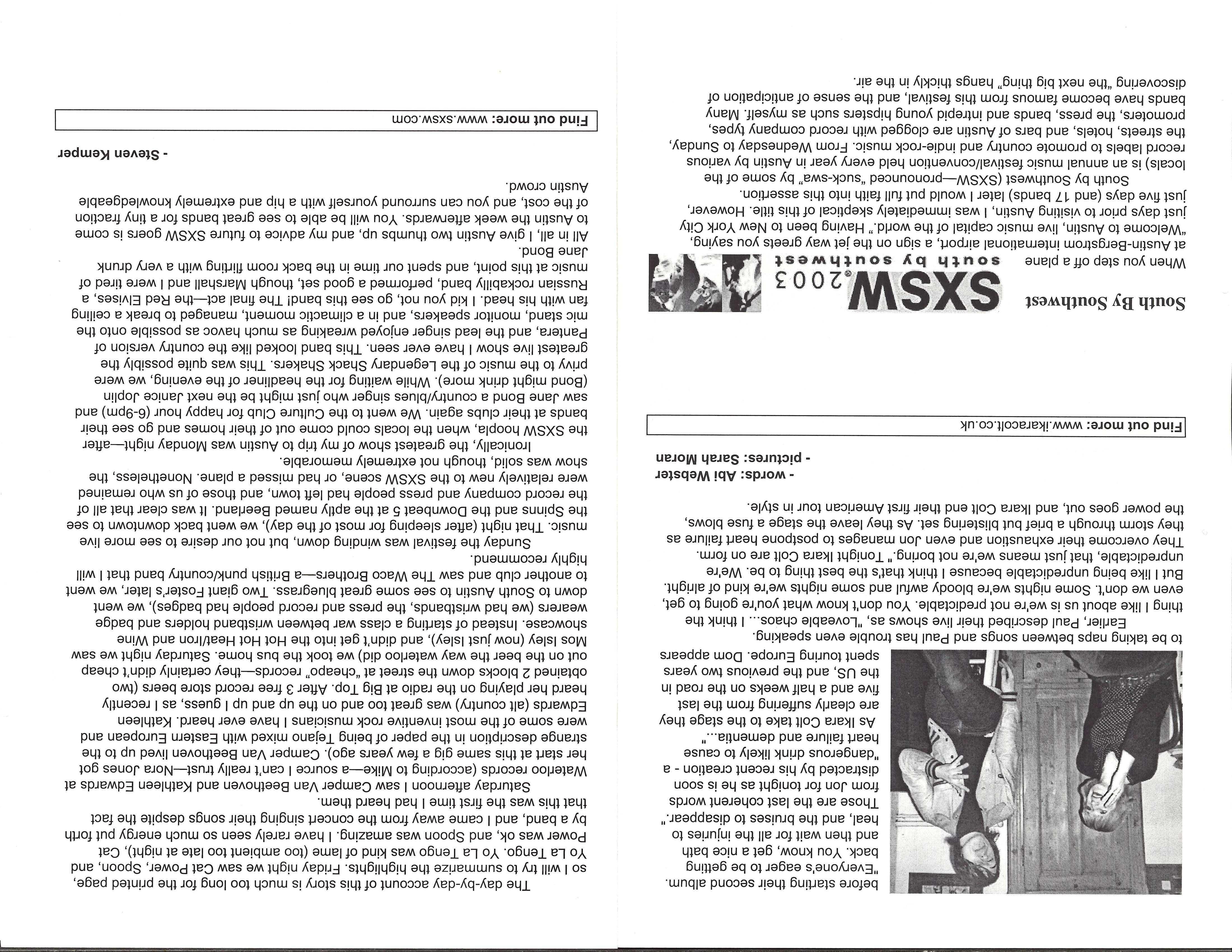
- words: Abi Webster - pictures: Sarah Moran
[Find out more: www.ikaracolt.co.uk
South By Southwest 5 X S 22003
When you step offa plane south by southwest at Austin-Bergstrom international airport, a sign on the jet way greets you saying, “Welcome to Austin, live music capital of the world.” Having been to New York City just days prior to visiting Austin, | was immediately skeptical of this title. However, just five days (and 17 bands) later would put full faith into this assertion. South by Southwest (SXSW—pronounced “suck-swa” by some of the locals) is an annual music festival/convention held every year in Austin by various record labels to promote country and indie-rock music. From Wednesday to Sunday, the streets, hotels, and bars of Austin are clogged with record company types, promoters, the press, bands and intrepid young hipsters such as myself. Many bands have become famous from this festival, and the sense of anticipation of discovering “the next big thing” hangs thickly in the air.
The day-by-day account of this story is much too long for the printed page, so will try to summarize the highlights. Friday night we saw Cat Power, Spoon, and
Yo La Tengo. Yo La Tengo was kind of lame (too ambient too late at night), Cat
Power was ok, and Spoon was amazing. have rarely seen so much energy put forth by a band, and came away from the concert singing their songs despite the fact that this was the first time had heard them.
Saturday afternoon saw Camper Van Beethoven and Kathleen Edwards at Waterloo records (according to Mike—a source can't really trust—Nora Jones got her start at this same gig a few years ago). Camper Van Beethoven lived up to the strange description in the paper of being Tejano mixed with Eastern European and were some of the most inventive rock musicians have ever heard. Kathleen Edwards (alt country) was great too and on the up and up guess, as recently heard her playing on the radio at Big Top. After 3 free record store beers (two obtained 2 blocks down the street at “cheapo” records—they certainly didn’t cheap out on the beer the way waterloo did) we took the bus home. Saturday night we saw Mos Isley (now just Isley), and didn’t get into the Hot Hot Heat/lron and Wine showcase. Instead of starting a class war between wristband holders and badge wearers (we had wristbands, the press and record people had badges), we went down to South Austin to see some great bluegrass. Two giant Foster’s later, we went to another club and saw The Waco Brothers—a British punk/country band that will highly recommend. Sunday the festival was winding down, but not our desire to see more live music. That night (after sleeping for most of the day), we went back downtown to see the Spinns and the Downbeat 5 at the aptly named Beerland. It was clear that all of the record company and press people had left town, and those of us who remained were relatively new to the SXSW scene, or had missed a plane. Nonetheless, the show was solid, though not extremely memorable. Ironically, the greatest show of my trip to Austin was Monday night—after the SXSW hoopla, when the locals could come out of their homes and go see their bands at their clubs again. We went to the Culture Club for happy hour (6-9pm) and saw Jane Bond a country/blues singer who just might be the next Janice Joplin (Bond might drink more). While waiting for the headliner of the evening, we were privy to the music of the Legendary Shack Shakers. This was quite possibly the greatest live show have ever seen. This band looked like the country version of Pantera, and the lead singer enjoyed wreaking as much havoc as possible onto the mic stand, monitor speakers, and in a climactic moment, managed to break a ceiling fan with his head. | kid you not, go see this band! The final act—the Red Elvises, a Russian rockabilly band, performed a good set, though Marshall and were tired of music at this point, and spent our time in the back room flirting with a very drunk Jane Bond. All in all, give Austin two thumbs up, and my advice to future SXSW goers is come to Austin the week afterwards. You will be able to see great bands for a tiny fraction ofthe cost, and you can surround yourself with a hip and extremely knowledgeable Austin crowd.

- Steven Kemper
Find out more: www.sxsw.com
If | had to pick one concert IN A
TORY to attend, I’d probably go to:
have posed this question in various states of awareness to many of my friends and other people can’t remember. In the past have offered up this question and then listened thoughtfully before passing out and dreaming of rock stars. When | suggested that the new WBOR magazine have a regular column where DJs or dedicated WBOR listeners (another thing | dream about...) could answer this question, never fully realized just how daunting a query this subject is. Your rock music time warp pass thing only works once so you gotta pick well. Scary, eh?
For me the selection process was almost more fun than the actual pick. | gathered my rock music books, my music DVDs and, most importantly, my sprawling CD collection sat down and tore through them. After going over everything for way too long and thinking way too hard about this question had to come up with a personal guideline to help make my overwrought decision: the band has to be significant and the performance/tour has to be noteworthy. What follows are my jumbled ruminations...
For a long time, seeing Guns N’ Roses had been a dream of mine. Appetite for Destruction era GN'R is about as pure as rock music gets. Honestly, have you seen Axl Rose's rap sheet—he wasn't kidding around. Before they canceled the Chinese Democracy tour, saw Axl and his current band posing as GN'R and while they were good, they have only gone further in solidifying Guns N’ Roses place in rock history as a the breeder of a whole terrible genre of hardcore hair metal bands and wife-beating losers. The book Our Band Could Be Your Life is all about the 80’s underground scene that we were all too young to experience. While the book chronicles some amazing performances, not all the bands really pass my rocksnob-imposed significance clause (read the book just for the Butthole Surfers stories). One band that was truly influential was Sonic Youth. Their tour in support of their most fully realized album Daydream Nation was with Neil Young and Crazy Horse on the tour which wielded Weld, one of my favorite live albums of all time. This was appealing to me, but both bands were pretty well established at this point so not snobby enough.
After much contemplation and agonizing, | eliminated Bob Dylan’s first electric tour in ’64. His backing band for the tour was The Band. No, l’m serious. also decided | probably wouldn't remember one of the many free concerts for the Grateful Dead played in their early Haight-Ashbury days even if did go. crossed off the Velvet Underground at Max’s Kansas City during their summer-long residency in 1970 (“Sweet Nothing” would have been the best encore ever). My last elimination was Jimi Hendrix’s performance at the Montery Pop Festival. Jimi lit his guitar on fire and humped the air as the reverb and feedback wailed... this was a real tough one to not choose. So, in response (and with no more space to explain my decision) I’d have to go with Pink Floyd at the Fourteen Hour Technicolour Dream Free Speech Festival in North London on Apr 28, 1967. Yeah, I’m sucker for early Floyd. A little bit of justification: Syd Barrett and the rest of the band had been honing their psychedelic magic for a year or so at the infamous UFO Club and this concert was their big debut. They were the headliners and had the top spot: they appeared at dawn. This concert was hugely significant and the acid flashbacks would guarantee | never forgot it.
- Cory Hiar
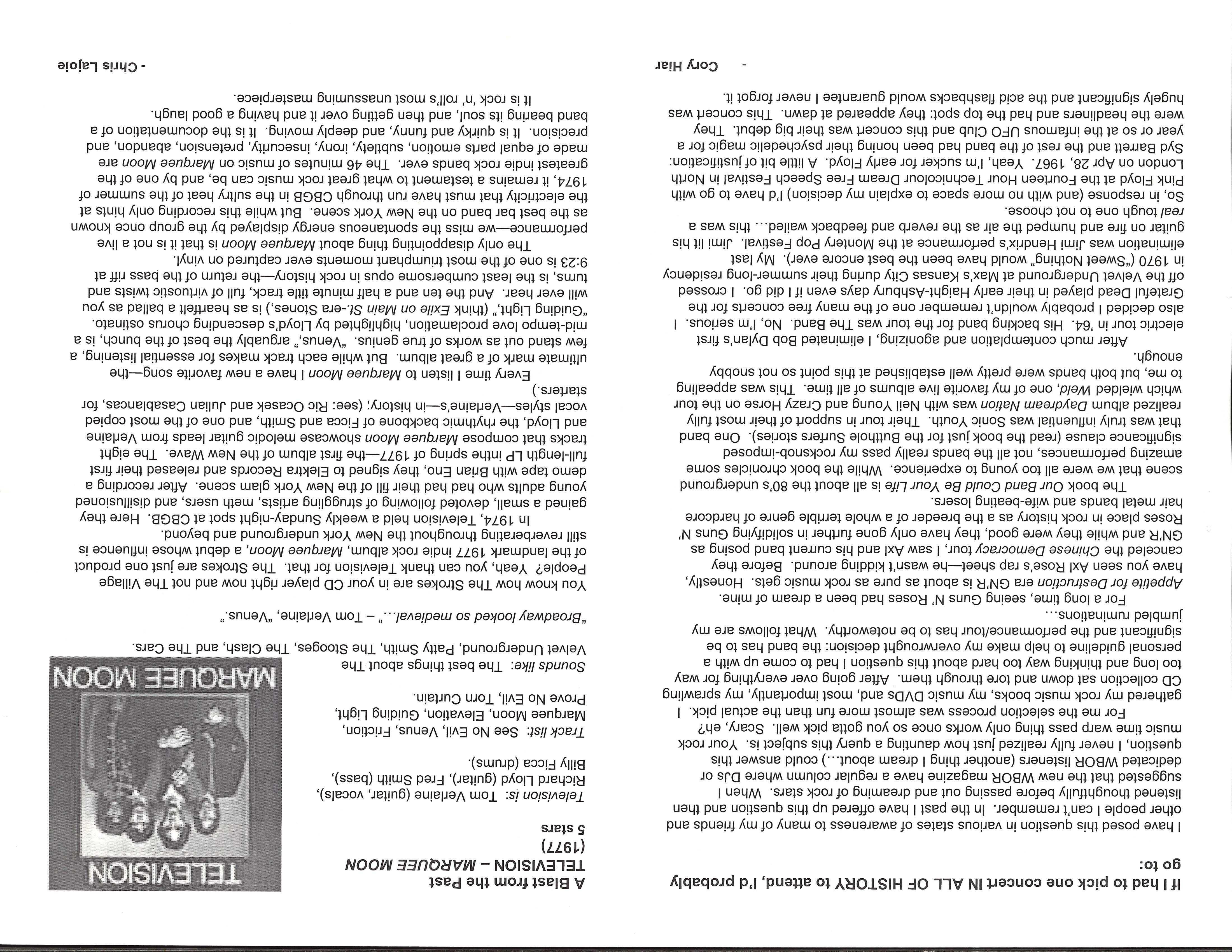
A Blast from the Past T
5 stars
Television is: Tom Verlaine (guitar, vocals), Richard Lloyd (guitar), Fred Smith (bass), Billy Ficca (drums).
Track list: See No Evil, Venus, Friction, Marquee Moon, Elevation, Guiding Light, Prove No Evil, Torn Curtain.
Sounds like: The best things about The as Velvet Underground, Patty Smith, The Stooges, The Clash, and The Cars.
“Broadway looked so medieval...” — Tom Verlaine, “Venus.”
You know how The Strokes are in your CD player right now and not The Village People? Yeah, you can thank Television for that. The Strokes are just one product of the landmark 1977 indie rock album, Marquee Moon, a debut whose influence is still reverberating throughout the New York underground and beyond. In 1974, Television held a weekly Sunday-night spot at CBGB. Here they gained a small, devoted following of struggling artists, meth users, and disillusioned young adults who had had their fill of the New York glam scene. After recording a demo tape with Brian Eno, they signed to Elektra Records and released their first full-length LP inthe spring of 1977—the first album of the New Wave. The eight tracks that compose Marquee Moon showcase melodic guitar leads from Verlaine and Lloyd, the rhythmic backbone of Ficca and Smith, and one of the most copied vocal styles—Verlaine’s—in history; (see: Ric Ocasek and Julian Casablancas, for starters.)
Every time | listen to Marquee Moon have a new favorite song—the ultimate mark of a great album. But while each track makes for essential listening, a few stand out as works of true genius. “Venus,” arguably the best of the bunch, is a mid-tempo love proclamation, highlighted by Lloyd's descending chorus ostinato.

“Guiding Light,” (think Exile on Main St.-era Stones,) is as heartfelt a ballad as you will ever hear. And the ten and a half minute title track, full of virtuostic twists and turns, is the least cumbersome opus in rock history—the return of the bass riff at 9:23 is one of the most triumphant moments ever captured on vinyl. The only disappointing thing about Marquee Moon is that it is not a live performance—we miss the spontaneous energy displayed by the group once known as the best bar band on the New York scene. But while this recording only hints at the electricity that must have run through CBGB in the sultry heat of the summer of 1974, it remains a testament to what great rock music can be, and by one of the greatest indie rock bands ever. The 46 minutes of music on Marquee Moon are made of equal parts emotion, subtlety, irony, insecurity, pretension, abandon, and precision. It is quirky and funny, and deeply moving. It is the documentation of a band bearing its soul, and then getting over it and having a good laugh.
It is rock ‘n’ roll’s most unassuming masterpiece.
- Chris Lajoie
NOTE: Marquee Moon is perfect for a New Wave party mix along with the following albums: Elvis Costello and the Attractions, This Year's Model; The Cars, The Cars; Talking Heads, Talking Heads ’77; and The Smiths, The Queen Is Dead.
Daylight Dies-No Reply Relapse Records
With Opeth's popularity rising in the underground, the melodic, depression metal subgenre known as doom-death is in vogue. In Daylight Dies, Relapse Records is releasing an album from a band that is very unlike most on its roster. While many well-known bands on Relapse like their music fast and technical, Daylight Dies favors a slow, plodding, style. Much of the music is certainly in the same vein as Opeth, but that's not to say the two are clones. The vocals on this album do not vary much as those of Opeth, nor does the band exhibit progressive tendencies as grand as Opeth's. Guthrie Idding's tortured cries are some of the most agonizing you will ever hear, which is very appropriate for a doom-death band. They complement the band's music quite well by enhancing the hauntingly beautiful atmosphere the band has created. And when it comes right down to it, that's what this music is all aboutatmosphere. The band certainly excels in creating an album embodying despair and depression. This album is perfect to listen to on a dark, rainy autumn day when there is a chill in the air. This is by no means a perfect album, however. It's the type of album you really have to be in a particular mood to listen to. While the musicians are very skilled and excel in their particular style, much of the material gets repetitive. There are only a few tracks which really stand out from the others-"In The Silence" and "Back In The World."
The first is an even slower, more somber tune than the rest, with some vocals spoken rather than screamed. This breaks up the monotony well. The second is an instrumental track which features some beautiful piano work by Idding.
The musicians are all excellent, particularly guitarist Barre Gambling. But when it comes to music like this, the band's collective sound is more important than individual efforts.
This disc is certainly worth listening to, especially if you're a fan of Opeth or doom-death in general. Just don't expect the second coming of Opeth.
- Ben Kreider
[For more info on Daylight Dies, check out www.daylight-dies.com.
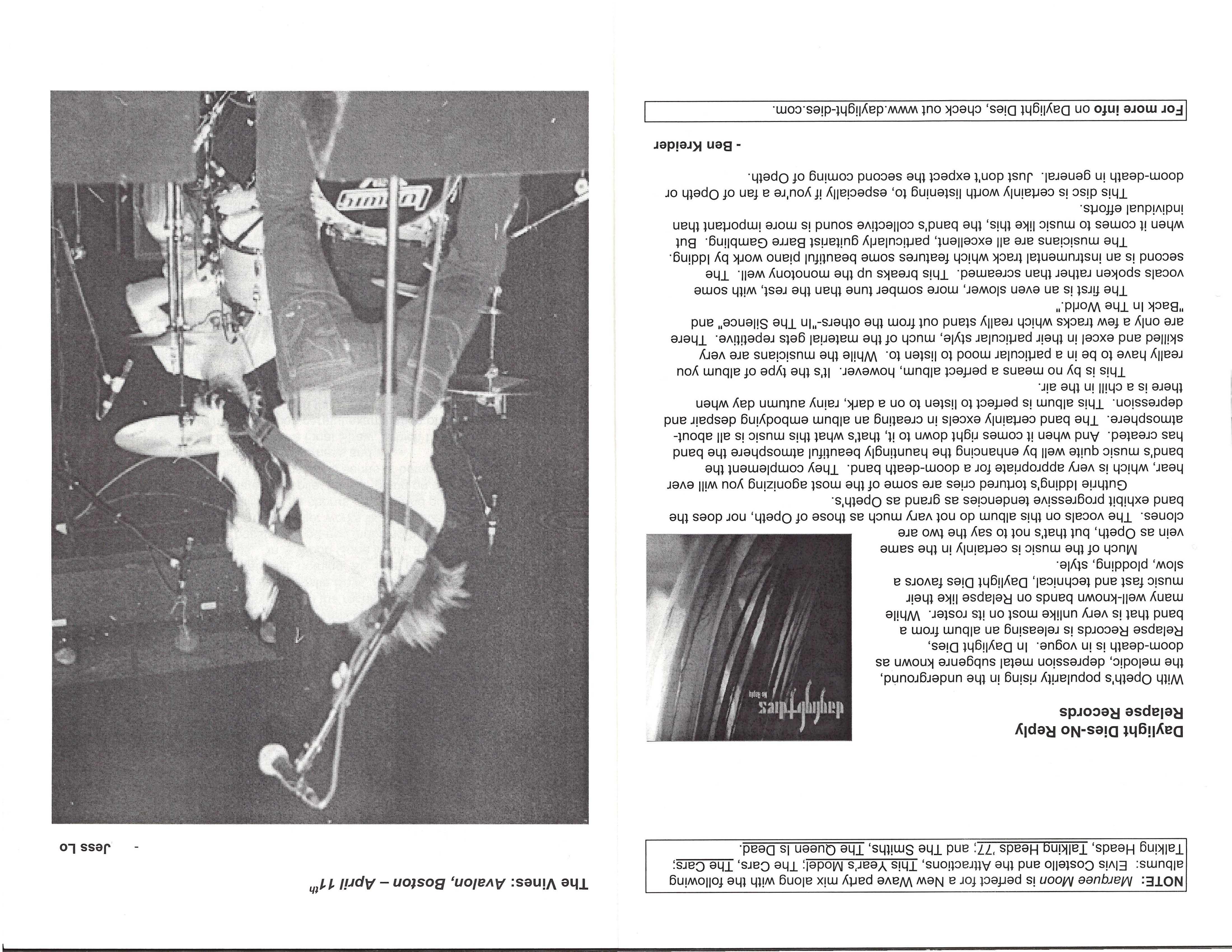

Music During Wartime : « ”
Edwin Starr, who S single “War” topped charts in the a a
1970’s with its antiwar anthem: “War! What is it good > for? Absolutely nothing,” died on April 2 at age 61 of Y heart failure, just as Coalition troops moved on Iraq. Are today's protest songs merely publicity stunts?
Has the heart and soul of protest songs been buried with him?
Since the Vietnam era, effective protest songs of musical and lyrical worth have been rare, most lacking the vigor and determination of their predecessors. There have been a few gems since, like The Talking Heads’ 1979 “Life During Wartime” blasting disco fans for their apathy. In 1984, Bruce Springsteen brought blue collar America’s concerns about war to light in “Born in the U.S.A.” set out on a quest, knocking on nearly every door in my dorm, asking if anyone had heard any protest songs about the recent war in Iraq. One person had heard “In A World Gone Mad” by The Beastie Boys. Another replied, “I’m sure Tori Amos has written one.” Other than that, nothing. So, sat down at my computer to look for these new protest songs. “In A World Gone Mad,” available from The Beastie Boys official website, boasts a head-nod inducing beat and accompanying rapping (lacking the vocal intensity of earlier works like “Sabotage”). For a group of rap lyricists, the words are appalling. The chorus “In a world gone mad it’s hard to think right/ So much violence hate and spite/ Murder going on all day and night/ Due time we fight the nonviolent fight,” seems like a series of bumper, with an elementary rhythm and rhyme scheme devoid of cleverness and wit. Next, looked for R.E.M.’s “The Final Straw,” which | read could be found at their homepage, www.remhq.com. Upon careful examination of every link, couldn't find any mention of the song. Odd. would think that if they were serious about protesting the war, they might make it easy to find their song. Days later, | stumbled onto a that gave a more specific address for the song: www.remhq.com/finalStraw/finalstraw.html. The song has a characteristic R.E.M. guitar arrangement, with lethargic singing and some low key programmed drums towards the end. Lyrically, “The Final Straw” is strides ahead of “In A World Gone Mad,” but has some pretty lame lines like “There’s a hurt down down deep that has not been corrected” & “Love will be my strongest weapon.” However, the song is partially redeemed with the lines “Who died and lifted you to perfection?/ And what silenced me is written into law.”
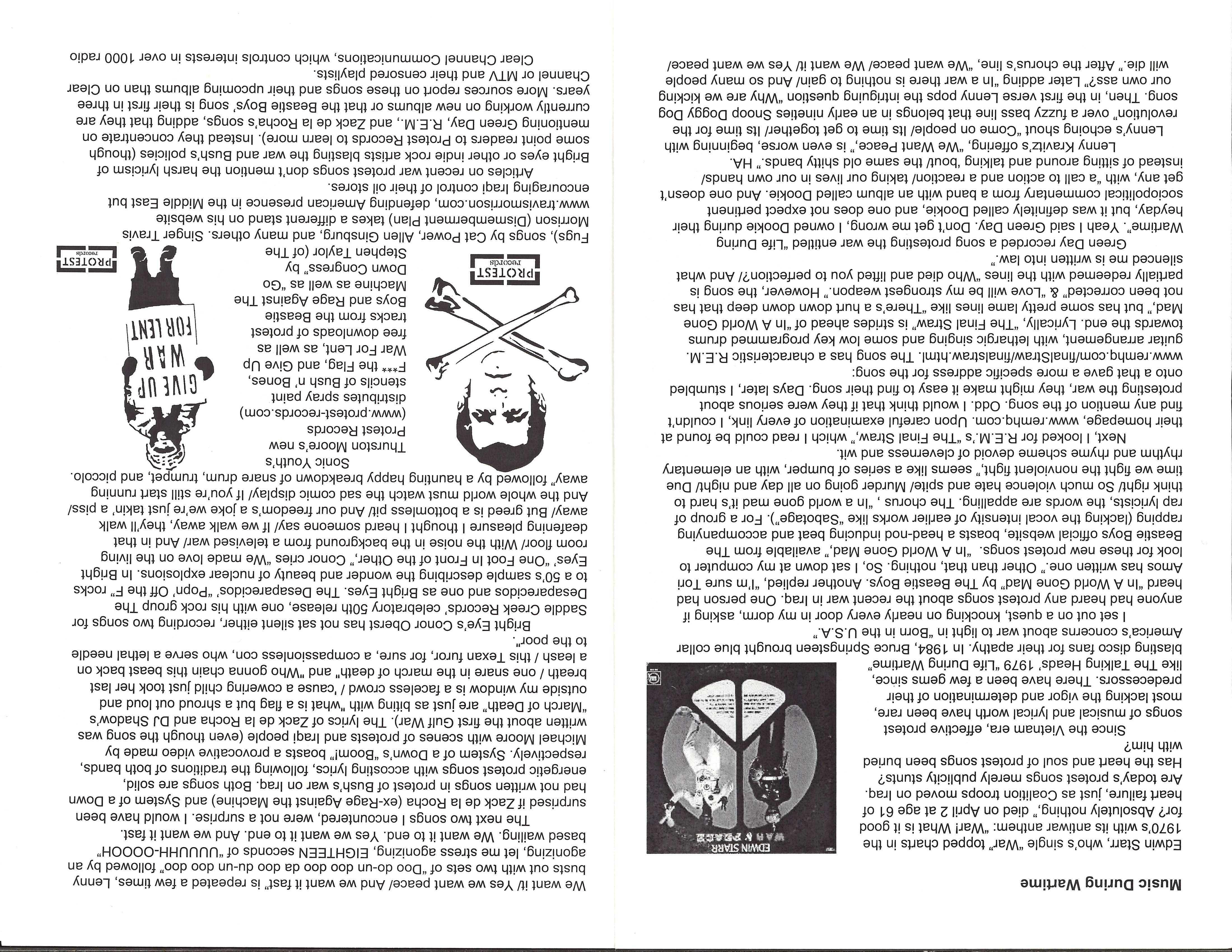
Green Day recorded a song protesting the war entitled “Life During Wartime”. Yeah said Green Day. Don’t get me wrong, owned Dookie during their heyday, but it was definitely called Dookie, and one does not expect pertinent sociopolitical commentary from a band with an album called Dookie. And one doesn't get any, with “a call to action and a reaction/ taking our lives in our own hands/ instead of sitting around and talking ‘bout/ the same old shitty bands.” HA.
Lenny Kravitz’s offering, “We Want Peace,” is even worse, beginning with
Lenny’s echoing shout “Come on people’ Its time to get together/ Its time for the revolution” over a fuzzy bass line that belongs in an early nineties Snoop Doggy Dog song. Then, in the first verse Lenny pops the intriguing question “Why are we kicking our own ass?” Later adding “In a war there is nothing to gain/ And so many people will die.” After the chorus’s line, “We want peace/ We want it/ Yes we want peace/
We want it/ Yes we want peace/ And we want it fast” is repeated a few times, Lenny busts out with two sets of “Doo do-un doo doo da doo du-un doo doo” followed by an agonizing, let me stress agonizing, EIGHTEEN seconds of “UUUUHH-OOOOH” based wailing. We want it to end. Yes we want it to end. And we want it fast. The next two songs encountered, were not a surprise. | would have been surprised if Zack de la Rocha (ex-Rage Against the Machine) and System of a Down had not written songs in protest of Bush’s war on Iraq. Both songs are solid, energetic protest songs with accosting lyrics, following the traditions of both bands, respectively. System of a Down’s “Boom!” boasts a provocative video made by Michael Moore with scenes of protests and Iraqi people (even though the song was written about the first Gulf War). The lyrics of Zack de la Rocha and DJ Shadow’s “March of Death” are just as biting with "what is a flag but a shroud out loud and outside my window is a faceless crowd / 'cause a cowering child just took her last breath / one snare in the march of death" and "Who gonna chain this beast back on a leash / this Texan furor, for sure, a compassionless con, who serve a lethal needle to the poor". Bright Eye’s Conor Oberst has not sat silent either, recording two songs for Saddle Creek Records’ celebratory 50th release, one with his rock group The Desaparecidos and one as Bright Eyes. The Desaparecidos’ “Popn’ Off the F” rocks to a 50's sample describing the wonder and beauty of nuclear explosions. In Bright Eyes’ “One Foot In Front of the Other,” Conor cries “We made love on the living room floor/ With the noise in the background from a televised war/ And in that deafening pleasure thought heard someone say/ If we walk away, they’ll walk away/ But greed is a bottomless pit/ And our freedom’s a joke we're just takin’ a piss/ And the whole world must watch the sad comic display/ If you're still start running away” followed by a haunting happy breakdown of snare drum, trumpet, and piccolo. Sonic Youth’s D: Thurston Moore’s new Protest Records (www.protest-records.com) distributes spray paint stencils of Bush n’ Bones, 6 F*** the Flag, and Give Up
SS mM s War For Lent, as well as N AR | tracks from the Beastie ° FOR LENT Boys and Rage Against The Machine as well as “Go

PROTESTI Down Congress” by Denreerl records PROTES ua Stephen Taylor (of The Ld Fugs), songs by Cat Power, Allen Ginsburg, and many others. Singer Travis Morrison (Dismemberment Plan) takes a different stand on his website www.travismorrison.com, defending American presence in the Middle East but encouraging Iraqi control of their oil stores. Articles on recent war protest songs don’t mention the harsh lyricism of Bright eyes or other indie rock artists blasting the war and Bush’s policies (though some point readers to Protest Records to learn more). Instead they concentrate on mentioning Green Day, R.E.M., and Zack de la Rocha’s songs, adding that they are currently working on new albums or that the Beastie Boys’ song is their first in three years. More sources report on these songs and their upcoming albums than on Clear
Channel or MTV and their censored playlists.
Clear Channel Communications, which controls interests in over 1000 radio
stations in America, sent a list of 162 songs to program managers of songs with
questionable or volatile lyrics that they suggest not be played. Clear Channel owns
135 live entertainment venues, including 41 amphitheaters in the U.S.A. and are
responsible for approximately 70 percent of concert ticket revenue in the U.S.A. in
2001. The company has since denied sending said list, which includes all Rage
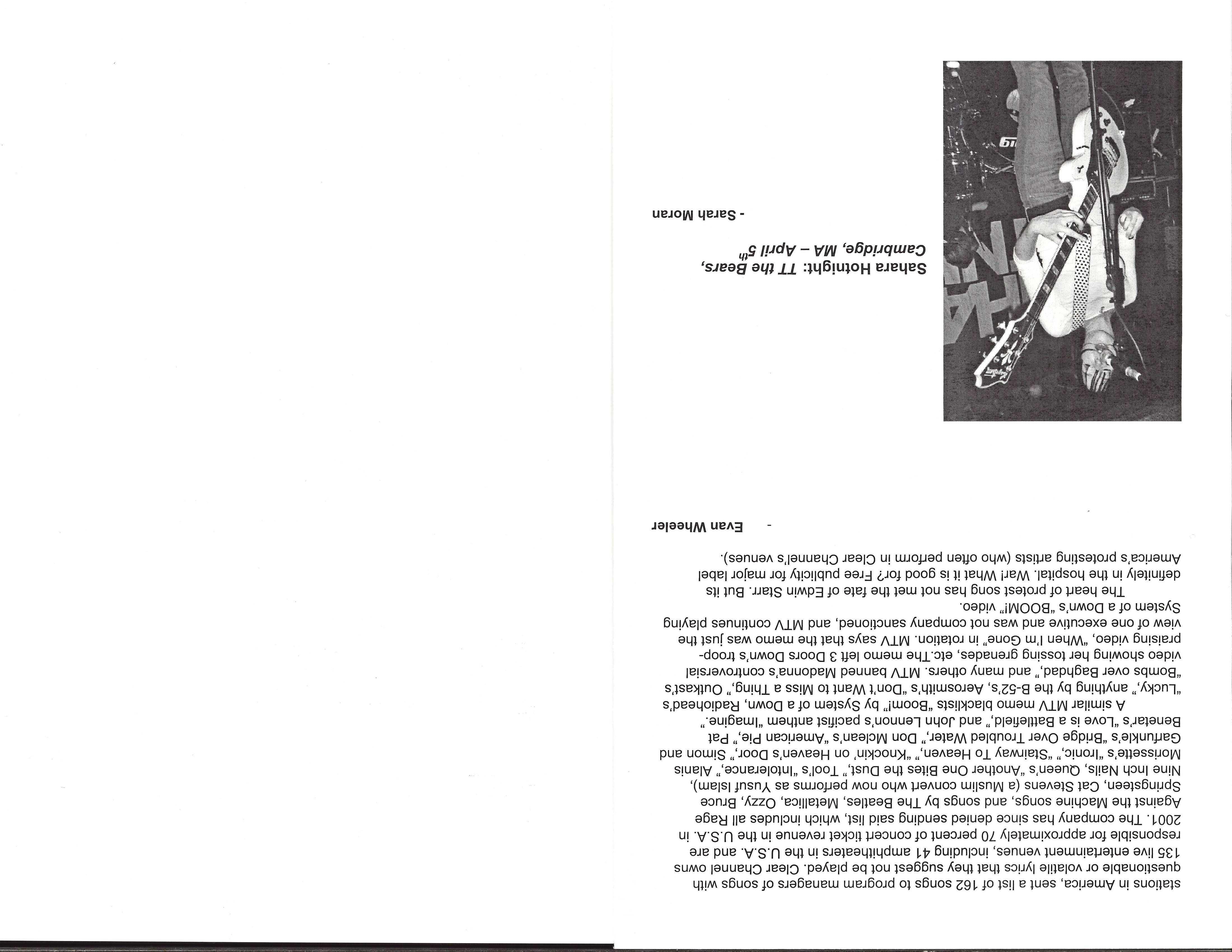
Against the Machine songs, and songs by The Beatles, Metallica, Ozzy, Bruce
Springsteen, Cat Stevens (a Muslim convert who now performs as Yusuf Islam),
Nine Inch Nails, Queen’s “Another One Bites the Dust,” Tool’s “Intolerance,” Alanis
Morissette's “Ironic,” “Stairway To Heaven,” “Knockin' on Heaven's Door,” Simon and
Garfunkle's “Bridge Over Troubled Water,” Don Mclean's “American Pie,” Pat
Benetar's “Love is a Battlefield,” and John Lennon's pacifist anthem “Imagine.” A similar MTV memo blacklists “Boom!” by System of a Down, Radiohead's “Lucky,” anything by the B-52's, Aerosmith's “Don't Want to Miss a Thing,” Outkast's “Bombs over Baghdad,” and many others. MTV banned Madonna’s controversial video showing her tossing grenades, etc. The memo left 3 Doors Down's trooppraising video, “When I’m Gone’ in rotation. MTV says that the memo was just the view of one executive and was not company sanctioned, and MTV continues playing System of a Down’s “BOOM!” video.
The heart of protest song has not met the fate of Edwin Starr. But its definitely in the hospital. War! What it is good for? Free publicity for major label America’s protesting artists (who often perform in Clear Channel’s venues).
- Evan Wheeler
Sahara Hotnight: TT the Bears, Cambridge, MA - April 5"
- Sarah Moran
